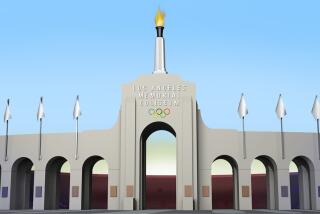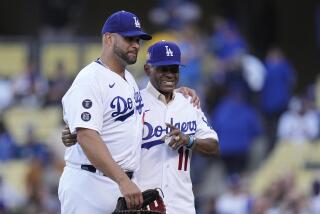FIELDER’S CHOICE : Toma: King of Diamonds Is Out Standing in His Field
- Share via
George Toma is a lot like Johnny Appleseed, except he doesn’t wear pots and pans on his head. What Toma often wears is a Kansas City Royals baseball cap and he spreads not apple seeds but The Word for what’s called the Turf Management Industry. The gospel according to Toma reads like the House and Garden spring supplement. Mr. Green Jeans of professional baseball.
Toma does this from Kansas City, Mo., which, with its cattle population, is a place where more manure is spread than anything else. Nevertheless, it’s been fertile ground for Toma’s 40-year career in converting cow pasture outfields and moonscape infields into playable surfaces. He goes about his work with the same missionary zeal that sent Albert Schweitzer on a 40-year hitch in the jungles of equatorial Africa. Except Toma would have tended more to the plants and trees than Gabon villagers. He would have surely established the cleanest ball park on the continent.
“There’s no better insurance for our boys and girls playing sports today than having a well-cared-for playing field,” Toma said. “These kids deserve the best fields we can give them. They need safe fields. Good football, soccer and baseball fields eliminate the risk of injury. I’m on the board of directors of the Sports Turf Managers Assn. and we are trying to bring attention to this problem in our high schools and city parks. Our city fathers and school directors need to be more concerned. My goal is to give everybody playing a game a field they can enjoy playing on. All you have to do is maintain the grass properly.”
This is a man who lives and breathes for grass and dirt. He’s the self-titled Nitty Gritty Dirt Man whose expertise is sought in all levels of football, baseball and any sport where athletes frolic on fields. Toma was even recruited by the State Department for a good will mission to Saudi Arabia to renovate their sandy soccer fields. That mission was aborted because it conflicted with the Royals’ spring training. Toma is Director of Fields and Landscaping for Kansas City. There are three practice fields at the Royals’ training complex in Fort Meyers, Fla, and each gets Toma’s personal attention.
“You gotta love your work,” he said. “We have three fields but only use two at any one time. A local high school uses the other. You know, I fix up that high school field just like our own. I like to give them the best field I can. A lot of cities and high school administrators think they don’t have the money or the time for this. It’s not expensive. All you have to have is pride in what you’re doing.
“There are people paying as much as $300,000 for the construction of a major league field, but it really should only cost $25,000. I think, at least on the professional level, the management should take some of the blame. If you look at most professional organizations, club owners have made a tremendous investment. They get the best trainers, the best doctors, the best weight rooms, pay huge amounts of money for the athletes. But when it comes to playing facilities, it’s another story. Everything stops right there.”
Toma’s passion for field maintenance had its genesis in 1946, when as a 16-year-old he dragged the infield for the Cleveland Indians in exchange for free admission to games. He says the first advice he got in the business was “Stay out of Kansas City.”
“This area--Kansas City, St. Louis, Cincinnati, Baltimore--is really the hardest place to grow a good field. You have to work a little harder. I was told I would be flooded out in the winter and in the summer the sun would bake me out. I thought of it as a challenge to work here, and it has been wonderful.
“I am concerned about the profession. Grounds maintainence is not as highly regarded as it should be. The tendency is to think we (groundsmen) are stupid--all we do is cut grass. The fact is we work very, very hard taking care of the fields. We have to be a nutritionist to know what to feed the grass, the proper amount of nitrogen and trace elements. You have to be a doctor to be able to tell when the grass gets a disease and know what to do. You have to be pharmacist to know what chemicals to use. You have to be a mechanic to use the machines. You have to be a plumber to design the watering system. “We love these fields. It can be tough. The press was on the San Francisco grounds crew, calling them the Sod Squad. But when the 49ers won the Super Bowl (in January) and the world championship, to me, the grounds crew became the world’s champions.”
Ask Toma the recipe for a world champion-field and he makes like Julia Child. It’s more than just grass and dirt, but that’s a good place to start.
Drainage: “There is always very good architectural plans for the stadium and the parking lot, but when it comes to the field, they think they can dump a lot of dirt and put a mound in the middle and say, ‘Go play.’ The most important part of the grass is not on top, it’s a good root zone. I like to have good drainage tile 18 inches deep every 10 feet or so. And I use Terra Bond, which acts as a filter between the soil and the tile.”
Grass: “What grass you use depends on what you use the field for and the region you’re in. I like Blue Grass (Poa) and a Rye called PhD. We also have good luck with Regal and Gator Rye. In California I like the tall fescues (the Alta Festuca strain from Oregon). Bermuda (Cynodon Dactylon) takes good wear and tear. I may cut the Bermuda down to 3/4-inch or so. But generally, I keep it to 1 inch and Bluegrass to 1 1/2. Always keep the infield grass the same length as the outfield grass. “Arification and fertilization, very important. Test your soil at least once a year. Keep the weeds out. Let it breathe. With some grasses, you have to top dress with sand. Bermuda likes to be top-dressed. This keeps it like a pool table. In California, I would put some sand in the topsoil. And I use pure sand for the grass in the bullpens.”
Dirt: “Sparky Anderson always said, ‘It’s not the dirt, it’s the man.’ True, true. Get dirt that fits. You have to be a chef to know what to add. No pebbles. Sand isn’t sand if you use too many fine particles, that can make it like concrete. Mix it up. It’s all in how you work the dirt. Keep your dirt going. We use clay in the batter’s box and on the pitcher’s mound. In California, you can’t find good clay.
“I like topsoil loam. Everybody like its. The secret is you can’t just put it there and leave it. I spend about an hour a day on the infield. Water it. Then drag it. I use a homemade drag from a sheet of nails. I pull it myself, two times.”
Toma suggests love and care is the key.
“There’s nothing more sad than to see a field going downhill. I want to present a beautiful field for the players and the fans. My motto is “May your good fortune be as numerous as blades of grass.”
More to Read
Go beyond the scoreboard
Get the latest on L.A.'s teams in the daily Sports Report newsletter.
You may occasionally receive promotional content from the Los Angeles Times.











